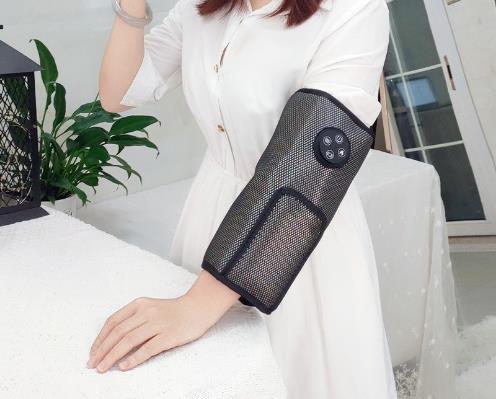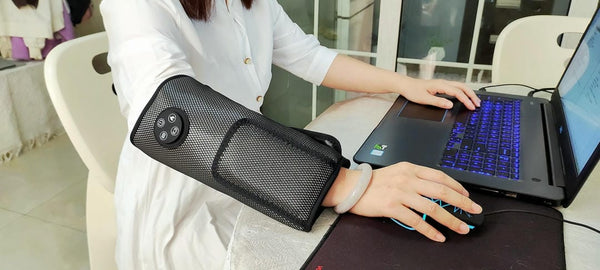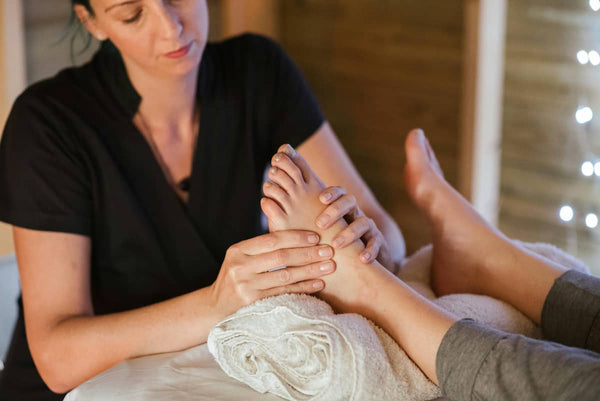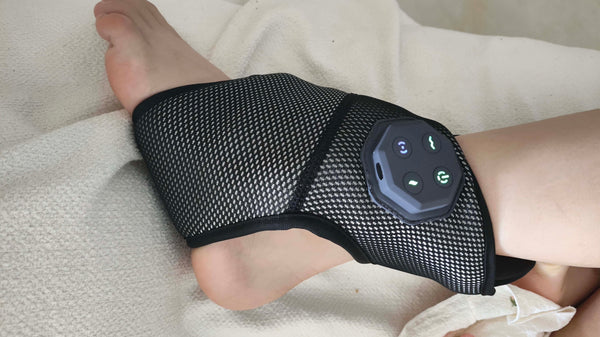
Do you ever feel that irresistible urge to move your legs, especially when you're trying to relax or, heaven forbid, sleep? That twitchy, crawly, sometimes downright uncomfortable sensation that just won't quit? If so, you're certainly not alone! This pesky feeling is often the hallmark of Restless Legs Syndrome (RLS), a neurological condition that affects a surprising number of people, often disrupting sleep and significantly impacting quality of life. Globally, it's estimated that RLS affects anywhere from 5% to 15% of the population, with prevalence increasing with age. [Data needed: Specific percentages for middle-aged and elderly fitness enthusiasts, Source: [Statistical Year]] While it's a genuine medical condition, many individuals seek non-pharmacological avenues for relief. Today, as your friendly neighborhood rehabilitation physiotherapist, I'm here to dive into whether a humble foot massager can truly be your secret weapon against the nighttime wiggles and provide some much-needed calm.
I believe it's essential to understand that RLS isn't just "ants in your pants"; it's a complex condition. The good news is, for many, simple interventions can make a big difference. Can a foot massager, with its gentle vibrations and soothing warmth, really stand up to the challenge? Let's unravel the mystery together and see how these devices might offer a moment of peace to your restless limbs.
Unraveling the Mystery: What's Really Behind Your Restless Legs?
So, what exactly is happening when your legs decide to throw a nightly party? Restless Legs Syndrome, or Willis-Ekbom Disease, is primarily considered a neurological sensory-motor disorder. While the exact cause isn't fully understood, it’s often linked to an imbalance of dopamine in the brain, which plays a crucial role in controlling muscle movement. Imagine dopamine as the conductor of an orchestra; when it's out of tune, the whole symphony of movement can get a bit chaotic. Additionally, low iron levels in the brain are often associated with RLS, even if your blood iron levels appear normal. It's quite a curious condition, isn't it?
From a physiotherapist's perspective, I've observed that the constant urge to move is often a direct response to these uncomfortable sensations. Movement, even just wiggling your toes or walking around, temporarily eases the symptoms. This is why many people find relief, albeit fleeting, from things like stretching or getting out of bed. It’s a bit like scratching an itch – you get momentary relief, but the underlying cause remains. Understanding this mechanism is key to seeing how tools like a foot massager might fit into your management strategy.
- Dopamine Imbalance: Often linked to RLS, impacting motor control pathways.
- Iron Deficiency: Low iron stores in the brain, even with normal blood levels, can contribute.
- Genetic Predisposition: RLS often runs in families.
- Nerve Signal Misinterpretations: How the brain processes sensations from the legs can be altered.
Tailored Relief: Exploring Different Foot Massager Types for RLS
Now, let's talk about the stars of our show: foot massagers! As a rehabilitation physiotherapist, I've seen a fascinating array of devices, each promising its own brand of relief. While no foot massager is a magic wand that cures RLS, many users report that they can certainly provide a welcome distraction and temporary alleviation of those irksome symptoms. It's about finding what feels right for *you* and your unique leg dance. Let's explore some common types and their potential benefits.
The Rhythmic Embrace of a Vibrating Foot Massager
When those legs start to twitch, a vibrating foot massager can feel like a godsend. The principle here is wonderfully simple: the gentle vibrations flood your sensory pathways, effectively "distracting" your brain from the uncomfortable RLS sensations. Think of it like this: your brain is receiving so much input from the vibrations that it temporarily puts the restless signals on mute. This isn't a cure, but it can be incredibly effective for temporary symptom relief, often allowing you to relax or even fall asleep.
These devices are particularly suited for individuals experiencing mild to moderate RLS symptoms, or for those moments when you just need quick, non-invasive relief during an episode. Many middle-aged and elderly fitness enthusiasts appreciate them as a drug-free option to help wind down after an active day, or when RLS flares up during quiet periods. From my experience, a consistent, gentle vibration can be like a soothing lullaby for your restless limbs.
- Principle Overview: Provides sensory input to override RLS sensations, acting as a distraction.
- Target Audience: Individuals with mild to moderate RLS, or those seeking temporary, non-pharmacological relief.
- Effectiveness: Anecdotal evidence suggests temporary symptomatic relief, helping to calm twitching and improve comfort. Results, however, vary greatly from person to person.
Soothing Warmth: The Power of a Heated Foot Massager
Sometimes, all your restless legs crave is a little warmth and comfort. That's where a heated foot massager steps in. The warmth generated by these devices can help improve circulation, relax tense muscles (which often accompany RLS symptoms), and simply provide a sense of deep comfort. While not directly addressing the neurological root of RLS, the physiological relaxation and increased blood flow can undoubtedly contribute to symptom alleviation.
A heated foot massager is particularly beneficial for those whose RLS symptoms feel worse in cold environments, or for individuals who experience accompanying muscle stiffness or cramps in their legs and feet. It's a wonderful option for unwinding before bed, creating a soothing ritual that signals to your body it's time to relax. Imagine sinking your feet into a cozy, warm embrace after a long day; it’s pure bliss for tired, restless legs.
- Principle Overview: Heat promotes circulation and muscle relaxation, providing comfort and reducing tension.
- Target Audience: Individuals whose RLS symptoms are exacerbated by cold, or those with concurrent muscle tension/cramps.
- Effectiveness: Offers temporary comfort and relaxation, which can indirectly alleviate RLS symptoms by promoting a calmer state.
Beyond the Gadget: The Simple Magic of Manual Foot Massage & Stretching
 While electronic gadgets are great, let's not forget the power of good old-fashioned manual therapy! As a physiotherapist, I often recommend simple stretches and self-massage techniques for RLS. The direct pressure and manipulation from a manual foot massage can target specific areas of tension, stimulate nerve endings, and improve local blood flow. This direct physical interaction can provide immediate relief, much like what many users report from a foot massager.
While electronic gadgets are great, let's not forget the power of good old-fashioned manual therapy! As a physiotherapist, I often recommend simple stretches and self-massage techniques for RLS. The direct pressure and manipulation from a manual foot massage can target specific areas of tension, stimulate nerve endings, and improve local blood flow. This direct physical interaction can provide immediate relief, much like what many users report from a foot massager.
This approach is suitable for virtually everyone, whether you have a fancy device or not. It's especially valuable for those seeking cost-effective or complementary methods. Simple calf stretches, ankle rotations, and gentle kneading of the foot muscles can be surprisingly effective. You might even consider a compression bandage for foot use if you find that light, consistent pressure helps soothe your symptoms. Sometimes, the simplest solutions, applied with care and consistency, are indeed the most effective ones!
- Principle Overview: Direct physical manipulation, stretching, and pressure can release muscle tension and stimulate circulation.
- Target Audience: All individuals with RLS, particularly as a first-line or complementary non-pharmacological strategy.
- Effectiveness: Often provides immediate, temporary relief by addressing muscle tension and nerve stimulation. Continuous use may lead to a reduction in frequency or intensity of RLS episodes for some people.
Navigating Your RLS Journey: Professional Advice & When to Seek Help
As your rehabilitation physiotherapist, I must emphasize this crucial point: while foot massagers can be fantastic allies in managing RLS symptoms, they are primarily for temporary, symptomatic relief. They're not a cure for the underlying neurological condition. Think of them as a comforting blanket on a chilly night – they make you feel better, but they don't fix the furnace. So, when should you rely on your trusty foot massager, and when is it time to ring up the doctor?
If your RLS symptoms are severe, persistent, significantly disrupting your sleep, or negatively impacting your daily life, it's absolutely time to seek professional medical advice. A doctor can assess for underlying causes like iron deficiency (and prescribe supplements if needed) or discuss prescription medications such as dopamine agonists. Your physician might also recommend exploring different therapeutic modalities or even referring you to a sleep specialist. For many, a multi-faceted approach, combining lifestyle changes, targeted exercises, and possibly medication, yields the best results. Don't suffer in silence when help is readily available.
- When to DIY: For mild, occasional symptoms or as a complementary therapy alongside medical management.
- When to Seek Medical Help: If symptoms are frequent, intense, interfere with sleep/daily activities, or if you suspect underlying causes.
- Proven RLS Strategies:
- Regular, moderate exercise (but not too close to bedtime).
- Avoiding triggers like caffeine, alcohol, and nicotine.
- Establishing good sleep hygiene [Internal Link: Sleep Hygiene Tips].
- Warm baths or showers.
- Leg stretches before bed.
- Addressing nutrient deficiencies (e.g., iron, magnesium).
Your Burning Questions Answered: FAQ on Foot Massagers & RLS
Does foot massage help neuropathy?
That's a great question, and it often gets a little muddled! While RLS is a neurological condition, it's distinct from neuropathy, which involves nerve damage. However, interestingly, foot massage can absolutely play a role in managing symptoms of neuropathy. By improving circulation, reducing muscle tension, and providing sensory input, massage can help alleviate discomfort, numbness, and tingling associated with conditions like diabetic neuropathy. It's about providing comfort and promoting overall foot health. So, while not a direct treatment for the nerve damage itself, a good foot massager can certainly be a helpful tool for symptom management in some types of neuropathy.
How to massage foot?
Learning how to massage foot effectively, whether with your hands or a device, can make a huge difference! For a manual approach, I recommend starting with gentle strokes across the sole and top of your foot. Use your thumbs to apply moderate pressure in circular motions, focusing on any tender spots or areas of tension. Don't forget your toes and ankles! Gently pull and stretch each toe individually, and rotate your ankles in both directions. If you're using a foot massager, start on a low setting and gradually increase the intensity to find what feels most comfortable and effective for you. Consistency is key here; a few minutes daily can often provide cumulative benefits.
Can diabetics use foot massagers?
This is a critical question, and the answer is nuanced: yes, but with caution and always after consulting your physician. For many diabetics, particularly those with good foot health and no severe complications, a foot massager can be beneficial for improving circulation and relieving general foot fatigue. However, if you have diabetic neuropathy with a loss of sensation, or if you have any open sores, infections, or poor circulation, the use of a foot massager might not be advisable. There's a risk of injury if you can't feel the pressure or heat, or if the device exacerbates existing conditions. Always prioritize safety and discuss it with your doctor or a podiatrist first. They know your specific health profile best!
Ready to take control of your RLS and find that longed-for peace? I believe that with the right tools and knowledge, you can significantly improve your quality of life. Don't let restless legs dictate your evenings or your sleep anymore!
Explore Recommended Foot Massagers! Subscribe for More Physio Tips & Updates!
This reply is generated based on currently verifiable public information. It is recommended to cross-check key content with authoritative sources.




0 comments